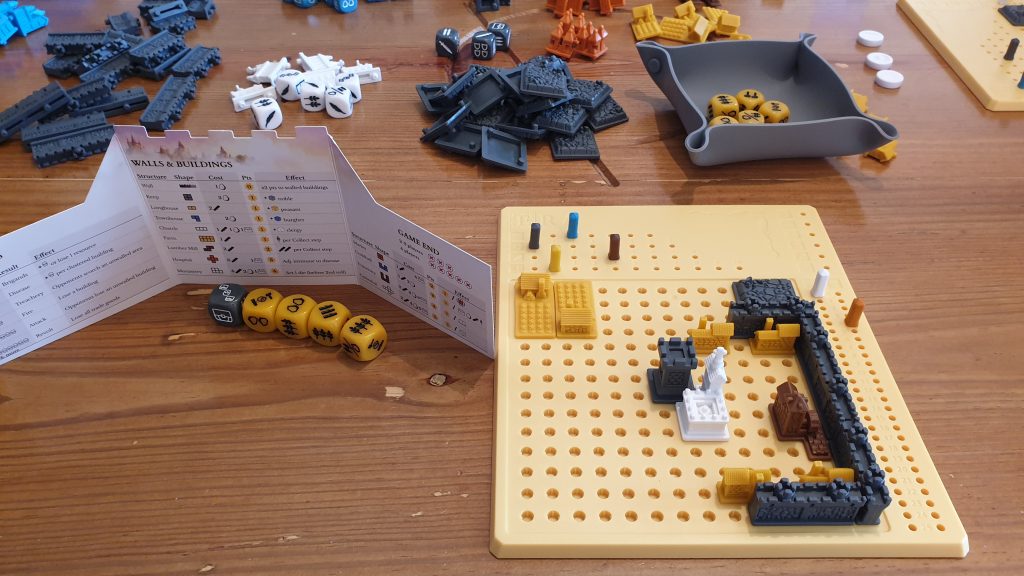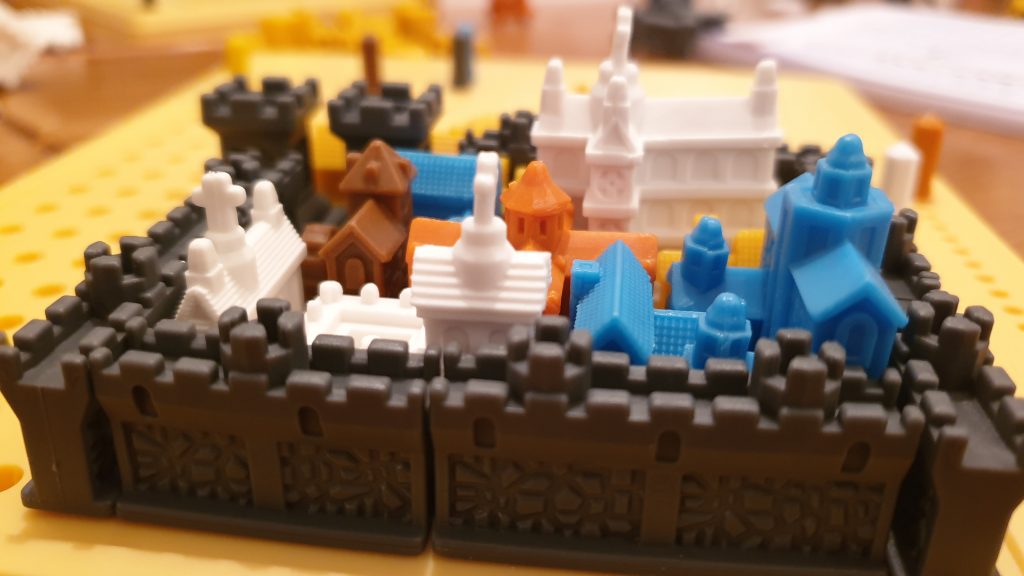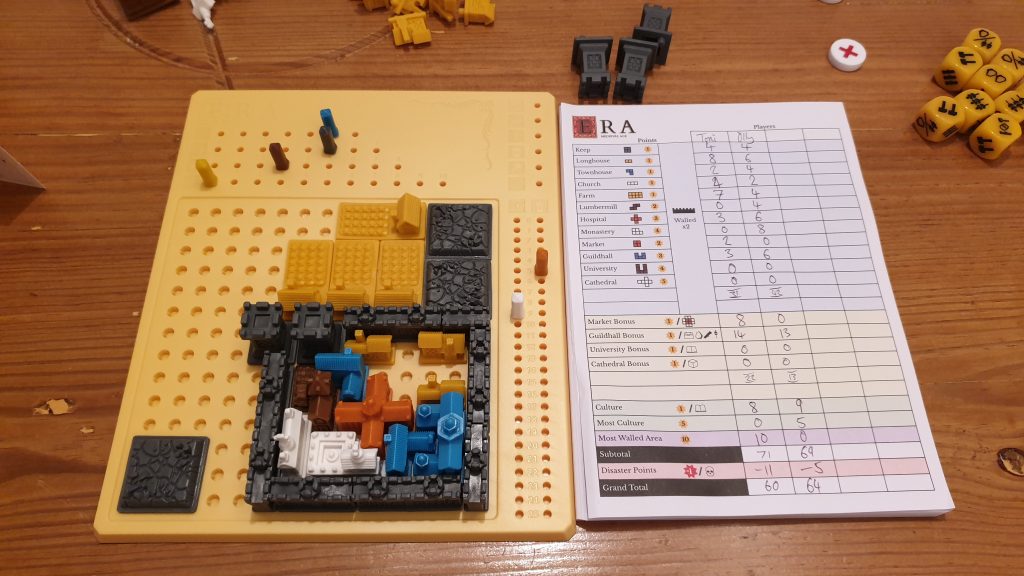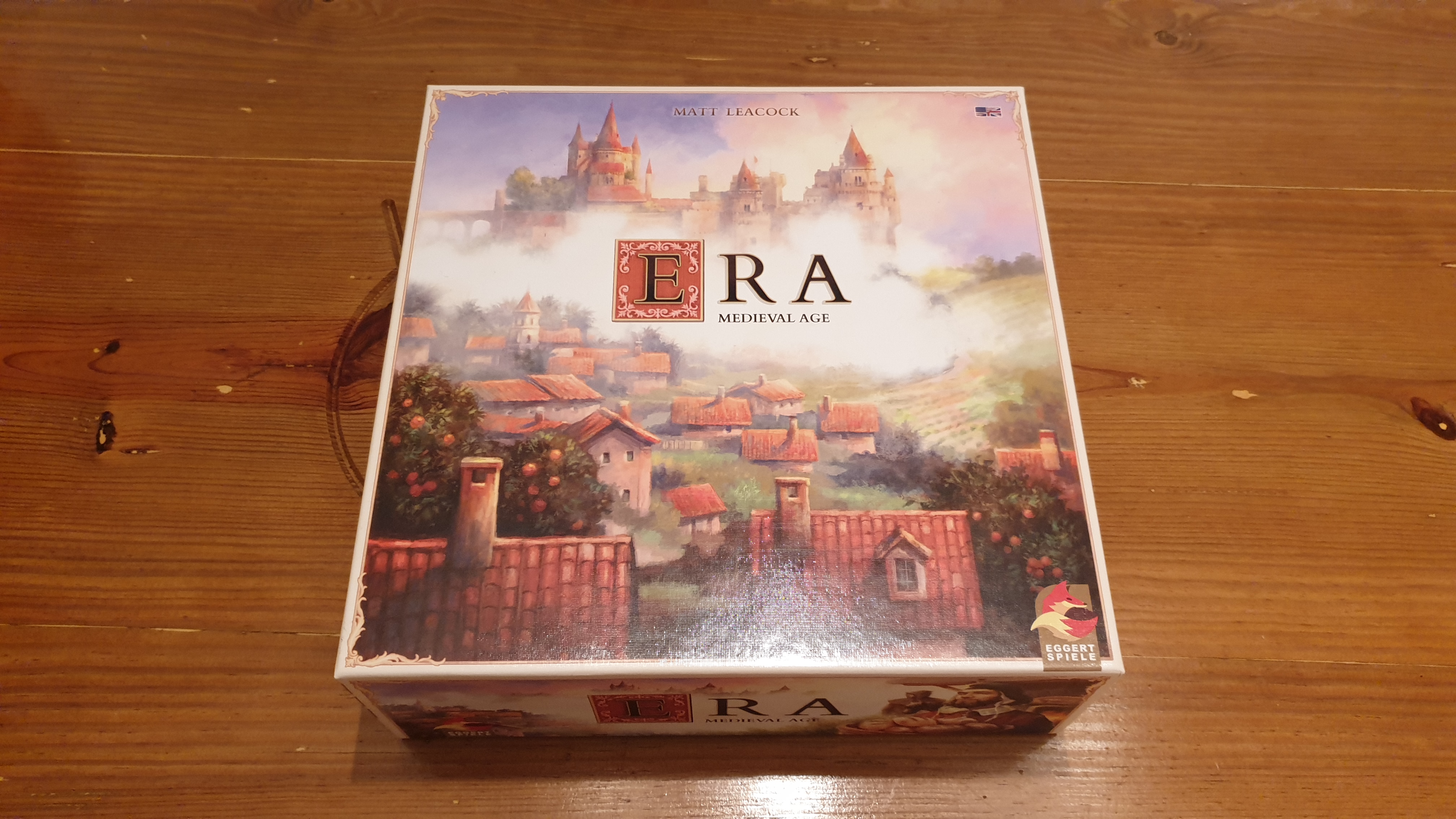Era Medieval Age is the brand new roll and build title, a twist on the roll and write genre, from publisher eggertspiele. Designed by the man behind the famed Pandemic series, Matt Leacock, featuring artwork from Chris Quilliams, 1 – 4 players attempt to build a medieval city. Taking around 40 minutes, peasants will be put to work, nobles will squabble, disease and fire will breakout and cities will grow. However, with dice rolling remaining, will the game miss the write aspect of the genre? Let’s find out!
Each player starts with a player board, pegs for the different trackers, 3 peasant dice, 1 noble die and a number of buildings. In terms of things each player starts equally. Aside from the starting keep, which must be central, the rest of the buildings can be placed anywhere on their player board – so there is variety from the offing. Each building type is laid out in the middle of the table, within reach, alongwith 3 or 5 tracking tokens depending on the player count.
Every round of Era Medieval Age is split into 6 easy to follow steps. Firstly, players roll all of their dice. Everyone may start with the same but before long players may have acquired different additional dice. Rolling skull symbols locks the dice but other dice can be rerolled a total of twice. Once everyone has finished rolling, resources are then collected from the dice. This is done by moving the associated pegs at the top of the player boards. Note, rolled skulls are not added to the disaster track. At this point farms each produce 1 food and lumber mills produce 2 wood.

Next, up is to feed all of your people. This is done by spending 1 food for each dice you have in your pool, with 1 disaster point earned for each die left unfed. The potential for negative disaster points isn’t over as the fourth stage of each round is disasters. This is where some push your luck is instilled into Era Medieval Age. Rolling 1 skull for example will lose the player a resource, while rolling 2 will see points lost for clustered buildings. Manage to get 3 skulls and the negative is pushed onto your opponents, given each a scorched earth tile they must place. Walled areas are safe from opponent’s offensive disasters – the first benefit of walling.
At this point for each Build symbol a player has rolled they can construct that many buildings. There are 14 different buildings in Era Medieval Age – something that is daunting at first. They all do unique things, coming with their own costs. While the Townhouse, which costs 2 stone, gives the player a blue (burghers) die, a Guildhall, which costs a whopping 5 wood and 2 stone, awards a point per resource at the end of the game. Due to the way that players slowly acquire some of these buildings players only need to know what their buildings do – allowing them to all be learnt during play. Whenever all of a building type is built a tracking token is flipped, getting the end of the game one step closer.
Lastly in a round is time for the Nobles to shine. For the most part, the point of the Noble dice is to offer swords or shields. In turn order players can take a single resource from each player with less swords rolled than them, unless they have enough shields to block the attack. Failing to do so or refusing will see you move two points down the disaster track.
When the six stages are over if all of the tracking tokens have been flipped the game is over. Counting up points each building type has a point value and potentially a scoring ability. For buildings their direct point values can be doubled if perfectly with city walls, the second benefit of walls. An example of the ability buildings is a Market. As well as having a specific point value, it scores a point per adjacent empty peg space. Note that ability based points aren’t doubled if within a walled area. There are then bonuses for whomever has the largest walled area and highest culture, before disaster points are subtracted. After calculating, whomever has the most points wins. Ties are split via resources otherwise the victory is shared.

Players are offered a good amount of choice throughout the game. Whether to reroll or stick with what the dice are currently offering. Which variety of buildings to build, then where to place it, or which to discard if fires breakout. There is always an element of randomness, due to the inclusion of dice. Though, the choice of how risky do you go is completely up to players. Building farms can boost your food production risk free, while lumber mills will see wood constantly pile up. These aren’t great for point scoring but make things safer.
If you are a player that might continually deliberate over every choice there is a lot here, which may slow the game down to a snail’s pace. The game is already a little slower than most roll and write style games. Mostly due to the way players build in turn and don’t just draw simultaneously. While it makes sense that everyone rolls the dice associated with their domain it is also a slower approach. It loses the speed of one player rolling the dice and everyone reacting to the same pool of dice – plus it opens up the inevitable luck argument when someone wins.
One aspect of Era Medieval Age doesn’t sit well for me is the push your luck to effectively attack opponents. The attraction of the game for me is building up a domain in the best possible way, without outside interference. Thankfully, even with players that like the take that mechanic it doesn’t dominate the game – just causing minor annoyances. There is certainly more of this conflict as the player count rises, so if you like take that in your games try a 4 player game – else stick to 3 players or less.

Overall, the use of symbology and a player aid for building effects is brilliant. This only makes it more surprising that there is often Skull vs. Disaster track confusion. Unlike resources, skulls rolled are not added directly to the disaster track as it would work intuitively. It’s intuitive as every other symbol that features on both the player board and dice work this way. It would have been easy to avoid this by using a different symbol so seems an odd oversight by eggertspiele. The issue is short lived but makes teaching the game that little more complicated.
Aside from this the components of Era Medieval Age almost nail it. The buildings have some details on them, not being just solid outline shapes. They easily fit onto the peg board, with knocking the board causing no issues whatsoever. The dice are top quality and a pleasure to roll. The provided screen to roll behind does a great job at being a reminder card – helping new and experienced players alike. The peg system used for resources is a simple one but does encounter the final negative aspect. The symbols to denote which track is which are unreadable at most angles. The publisher has clearly noticed this. New versions of the game come with a sticker set to fix this – so just make sure if you get the game it comes with those included. Somewhat saving this is that the peg colours match the resource types, so it isn’t a game breaking problem anyway.
Era Medieval Age feels like the ultimately upgraded roll and write, with a small map growing before you on the table. It comes with some of the same issues that roll and write games come with, like needing to keep the pace up. With many decisions to make, from the very beginning of the game, it doesn’t make this inherently easy to do. Yet, Era Medieval Age presents an interesting puzzle to crack, with multiple routes to victory. No single choice is hard to make but they combine throughout the game to matter. The game does something roll and write titles cannot do and that is to have an epic table presence. Whether roll and build will catch on we shall have to see but this one is one to experience.
[Editor’s Note: Era Medieval Age was provided to us by Asmodee for review purposes. The game is currently available from local board game stores, find your local store here.]

